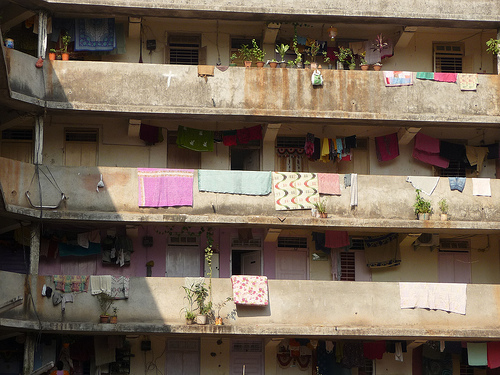![]() photo credit: Dan..
photo credit: Dan..
India is the second highest populated country in the world with nearly 1.3 billion populations contributing to 17% percent of world population. It is expected that the trend if continues will exceed China in 2030 with an estimated 1.53 billion people living on this motherland. This is really scary as the resources to support this population are not growing at the pace expected and scarier is the urban population will be almost 50% by 2050. Presently though the urban population is at 27.8% the rate of urbanization is overshooting the predictions of our so-called planners and social scientists. With this growth scenario the demand for housing in urban areas also has grown considerably and since six decades the urban development policies by the various governments in power have hardly taken any initiative to bridge the gap between “Demand and Supply”. Hence one may say that the housing sector; particularly public housing in India has not delivered and the deficit still keeps growing in millions and presently if the calculations are right it stands at 24.7 million units. If numbers do not tally then the quality and comfort aspects of the housing units delivered so far is equally alarming. In a hurry to satisfy numbers we forget or sideline the quality of living and the conditions of comfort where a person can bet at optimum both psychologically and physiologically. Traditionally in India the vernacular architecture provides a variety of architecture as a response to the micro and macro climatic and socio-cultural situations. For instance in south Tamil Nadu, the coastal houses have “kattuppandal” as a significant feature of architecture which is the “Wind Catcher” facilitating air movement required as comfort criteria for a Warm Humid Condition.
In the year 1984 I had joined the Bartlett School of Architecture and Planning, UCL London for my post graduation in Architecture with a specialization in Environmental Design. The first few weeks of the course was only about Human Psychology and Physiology. We had to read “Sensations and Perceptions” by Stanley Coren, Lawrence M Ward, James T Enns. My professor at that time was Dr Ron. Hawks a renowned name in the field of Space Psychology in Built Environment. We were experimenting extensively on human body and the function of “Hypothalamus” in the brain in relation to human comfort. At some point I thought I had joined a wrong course and I wanted to quit. However I pursued further and by the first quarter I realized the connection between human comfort and architecture. Architecture is a unique phenomenon that has a delicate connection between the people and the space that they occupy. A Danish professor P Ole Fanger at the Technical University of Denmark who defined comfort not only on qualitative terms but also with an equation involving various parameters to assess the level of comfort quantitatively developed the concept of Comfort and more importantly “Thermal Comfort”. Hence comfort according to him was “ A state at which a human being feels both psychologically and physiologically at equilibrium so as to perform at optimum level”.
This complicated comfort equation is the most commonly adopted. It is based on experiments involving humans exposed to a uniform environment under steady state conditions. The comfort equation establishes the relationship among the environment variables, clothing type and activity levels. Hence, the equation gives information on how to predict Predicted Mean Vote (PMV) which is the mean vote expected to arise from averaging the thermal sensation vote of a large group of people in a given environment. The aspects of PPD- Percentage People Dissatisfied and LPPD-Lowest Percentage People Dissatisfied was evolved. He went on to experiment and say that LPPD was 5% given a perfect environment. Hence whatever environment one creates or assumes perfect there seems to be a dissatisfaction level of 5%.
The thesis on “Thermal Comfort in Housing” submitted by me at the University of London in 1985 experimented some of the public housing schemes in Chennai and also the computer model developed by HUDCO for the sites and services schemes which were quite popular those days. The thesis results alarmingly showed how the very aspect of bio-climatic and comfort criteria were hardly applied to these housing schemes. The results further predicted the discomfort level as very high encouraging psychological and physiological stress and other health complications.
The public housing programmes today talk about “Sustainable Development” and the housing policy 2007 document stresses the need for conservation of natural resources and formulation of regulations & bye-laws that are environment friendly, investment-friendly and revenue-generating. This seems to be a good trend and quite a departure from the early eighties. But the question is how far these regulations and environmental friendly policies are implemented, monitored and enforced.
We all know that the building sector accounts for a significant and increasing part of the worldwide energy consumption and is responsible for important greenhouse gas emissions. This is why rational use of energy and development of renewable energy sources appear as strategic solutions considering the significant resources available. In this context, energy efficiency in the building sector and particularly the Housing sector will be more and more considered as a key issue of the future and will be a challenging task for the state sponsored housing agencies whose deficit goes in millions by every year.

